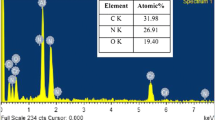Abstract
Evaluation of the characteristics of a microelectrical discharge machining (Micro-EDM) process is challenging, because it involves complex, interrelated relationships so a proper modeling approach is necessary to clearly identify the crucial machining variables and their interrelationships in order to initiate more effective strategies to improve Micro-EDM qualities (electrode wear (EW), material removal rate (MRR) and overcut). This paper uses a response surface method (RSM) based on the central composite design (CCD) for Micro-EDM problems with four EDM variables (peak current, pulse on-time, pulse off-time and electrode rotation speed). Experimental results indicate that peak current is the EDM variable that most affects the Micro-EDM qualities for SK3 carbon tool steel while pulse off-time had a significant interaction with that. The results show that RSM based on the CCD could efficiently be applied for the modeling of Micro-EDM qualities (EW, MRR, and overcut), and it is an economical way to obtain the performance characteristics of Micro-EDM process parameters with the fewest experimental data.
Similar content being viewed by others
References
Son SM, Lim HS, Kumar AS, Rahman M (2007) Influences of pulsed power condition on the machining properties in micro EDM. J Mater Process Technol 190:73–76
Han F, Jiang J, Yu D (2007) Influence of machining parameters on surface roughness in finish cut of WEDM. Int J Adv Manuf Technol 34:538–546
Egashira K, Matsugasako A, Tsuchiya H, Miyazaki M (2006) Electrical discharge machining with ultralow discharge energy. Precis Eng 30(4):414–420
Liu K, Lauwers B, Reynaerts D (2010) Process capabilities of Micro-EDM and its applications. Int J Adv Manuf Technol 47:11–19
Peng ZL, Wang ZL, Dong YH, Chen H (2010) Development of a reversible machining method for fabrication of microstructures by using micro-EDM. J Mater Process Technol 210:129–136
Pham DT, Dimov SS, Bigot S, Ivanov A, Popov K (2004) Micro-EDM—recent developments and research issues. J Mater Process Technol 149:50–57
Wong YS, Rahman M, Lim HS, Han H, Ravi N (2003) Investigation of micro-EDM material removal characteristics using single RC-pulse discharges. J Mater Process Technol 140:303–307
Aligiri E, Yeo SH, Tan PC (2010) A new tool wear compensation method based on real-time estimation of material removal volume in micro-EDM. J Mater Process Technol 210:2292–2303
Kilickap E, Huseyinoglu M, Yardimeden A (2011) Optimization of drilling parameters on surface roughness in drilling of AISI 1045 using response surface methodology and genetic algorithm. Int J Adv Manuf Technol 52:79–88
Natarajan U, Periyanan PR, Yang SH (2011) Multiple-response optimization for micro-endmilling process using response surface methodology. Int J Adv Manuf Technol 56:177–185
Djoudi W, Aissani-Benissad F, Bourouina-Bacha S (2007) Optimization of copper cementation process by iron using central composite design experiments. Chem Eng J 133:1–6
Aslan N (2008) Application of response surface methodology and central composite rotatable design for modeling and optimization of a multi-gravity separator for chromite concentration. Powder Technol 185:80–86
Sohani MS, Gaitonde VN, Siddeswarappa B, Deshpande AS (2009) Investigations into the effect of tool shapes with size factor consideration in sink electrical discharge machining (EDM) process. Int J Adv Manuf Technol 45:1131–1145
Tsao CC (2008) Comparison between response surface methodology and radial basis function network for core-center drill in drilling composite materials. Int J Adv Manuf Technol 37:1061–1068
Hang Y, Qu M, Ukkusuri S (2011) Optimizing the design of a solar cooling system using central composite design techniques. Energy Build 43:988–994
Box GEP, Wilson KB (1951) On the experimental attainment of optimum conditions. J R Stat Soc Ser B-Stat Methodol 13:1–45
Box GEP, Hunter JS (1957) Multi-factor experimental design for exploring response surfaces. Ann Math Stat 28:195–241
Obeng DP, Morrell S, Napier TJN (2005) Application of central composite rotatable design to modeling the effect of some operating variables on the performance of the three-product cyclone. Int J Miner Process 769:181–192
Crozier RD (1992) Flotation theory, reagents and ore testing. Pergamon, New York
Author information
Authors and Affiliations
Corresponding author
Rights and permissions
About this article
Cite this article
Lin, Y.C., Tsao, C.C., Hsu, C.Y. et al. Evaluation of the characteristics of the microelectrical discharge machining process using response surface methodology based on the central composite design. Int J Adv Manuf Technol 62, 1013–1023 (2012). https://doi.org/10.1007/s00170-011-3745-0
Received:
Accepted:
Published:
Issue Date:
DOI: https://doi.org/10.1007/s00170-011-3745-0




